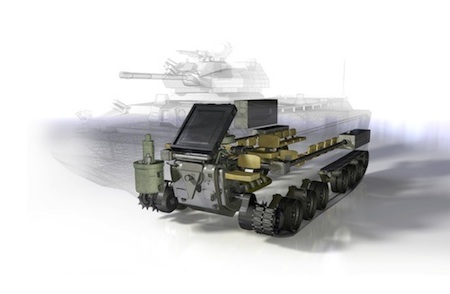Latest News
May 3, 2013
It’s no surprise that the winner of the $1 million prize in DARPA’s Fast Adaptable Next-Generation Ground Vehicle (FANG) mobility/drivetrain challenge was a three-person team with members dispersed in Ohio, Texas, and California.
The challenge, the first of which kicked off in January, aims to spark innovation around the design of the vehicle, not only from inside traditional defense industry circles, but also from the outside world. Equally important to the competition, however, was putting a new genre of development tools to the test in the hopes of significantly compressing the design-to-production cycle of complex defense systems, according to Army Lt. Col. Nathan Wiedenman, program manager for the Defense Advanced Research Projects Agency (DARPA).
Specifically, the FANG Challenge tasked teams to use the META design tools and model libraries along with the VehicleFORGE collaboration platform developed by Vanderbilt University to design and simulate the performance of potential mobility and drivetrain subsystems. VehicleFORGE is the collaborative platform used by competitors to manage and submit their designs from geographically separate locations in the DARPA FANG Challenges. The META design tools were developed to raise the level of abstraction on the design of complex defense systems, enable rapid exploration of high-fidelity design trade-offs, and yield detailed, predictably correct designs, Wiedenman says.
By deploying these next-generation tools in a real-world design scenario, DARPA is able to gather first-hand insights into how these platforms perform, including their ability to enable dispersed engineering teams and outside collaborators to work more effectively to meet DARPA’s goal of five-fold reduction in the design cycle.
“DARPA obtained a great deal of valuable feedback from the FANG Challenge, including ideas for improving the usability of the tools, the robustness of the models, and capabilities required for the development of more complex designs,” Wiedenman explains. “While the META tools are not yet fully mature, the FANG Challenge helped to prove that the underlying principles are sound and that DARPA’s goals for compressing design-to-production design are feasible.”
Since the beginning of the first FANG Challenge in January, more than 1,000 participants within 200 teams have leveraged both tool sets. Ground Systems scored highest in the three main categories used to judge entries: performance, lead time, and unit cost. Lead time was particularly emphasized in the scoring model, Wiedenman says, because of the emphasis on compressing the design-to-production times.
While there are no formal plans for the FANG Challenge tools beyond the competition, Wiedenman anticipates they will play a role in future development efforts. “We have the potential to create a whole new engineering and system development paradigm, disrupting the current approach to building not only military vehicles, but all forms of complex defense systems,” he says. “It is premature to assess our progress toward that, but we would anticipate the tools and processes developed would have life beyond the FANG Challenges with opportunity to transcend into commercial industry.”
A video preview of the FANG Challenge tools can be viewed below.
Subscribe to our FREE magazine, FREE email newsletters or both!
Latest News
About the Author
Beth Stackpole is a contributing editor to Digital Engineering. Send e-mail about this article to [email protected].
Follow DERelated Topics







